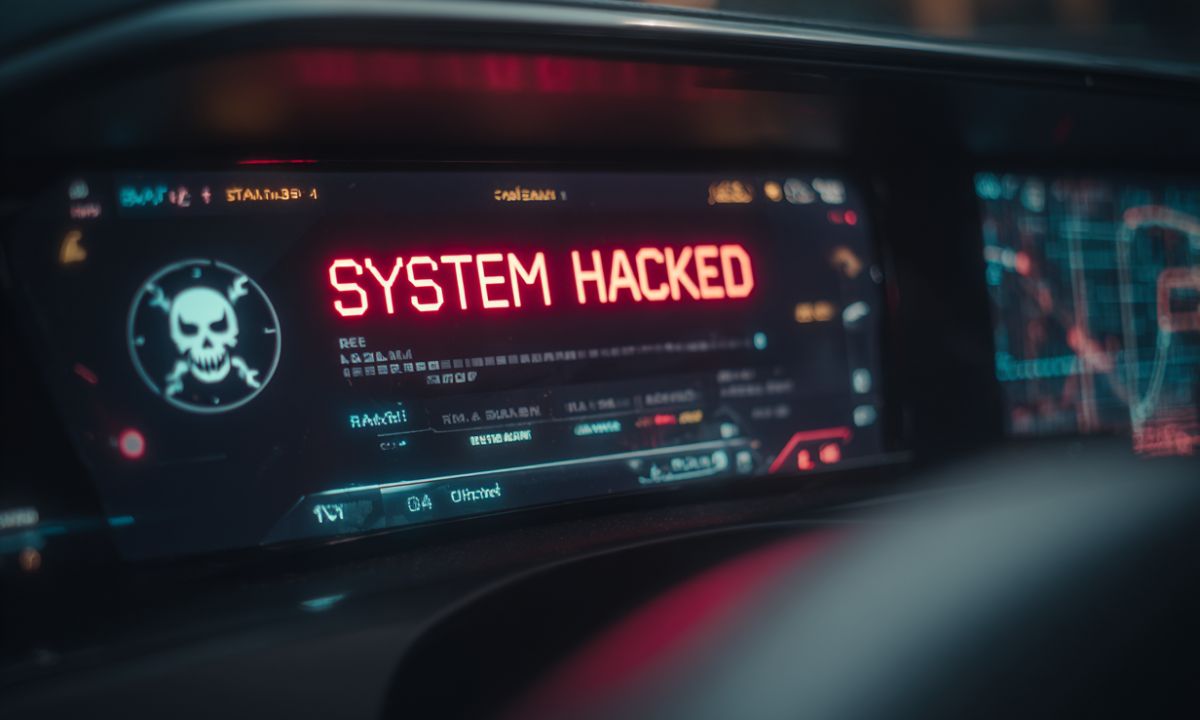Cybersecurity on the Road: Hacking Threats to Connected Cars in Queensland and Impact on Driver Safety

Picture this: you're cruising along the Pacific Motorway and soaking up the Queensland sunshine, when suddenly your steering wheel jerks sharply to the left, your brakes fail to respond, and your dashboard displays an ominous message: "Your vehicle has been compromised."
This is no longer just a scene reserved for science fiction movies. As cars become increasingly connected, they're also becoming more and more vulnerable to cyber threats, putting Queensland drivers at risk.
The Digital Revolution on Wheels
Modern vehicles are now sophisticated computers on wheels. The average car today requires more than 100 million lines of code and dozens of Electronic Control Units (ECUs), which manage everything from engine performance and climate control to entertainment and navigation systems.
"Connected car cybersecurity is a paramount concern as the automotive industry undergoes a monumental transformation," according to a recent industry report. "This profound interconnectedness introduces a vast and intricate web of vulnerabilities, making cybersecurity a critical imperative. A single breach could escalate from a mere inconvenience to jeopardise occupant safety and public trust."
For Queensland drivers, this digital revolution has brought about both improved convenience and heightened concern. While innovative features like keyless entry, GPS navigation, and smartphone integration may make driving more enjoyable, they also create potential entry points for malicious actors.
Emerging Threats: From Theoretical to Tangible
The cybersecurity landscape for connected vehicles is evolving rapidly, which has seen the emergence of several key threats:
Remote Vehicle Hijacking
The most immediate and worrying threat is remote takeover. In 2024, security researchers discovered a vulnerability in Kia's web portal that allowed them to reassign control of internet-connected features of any Kia vehicle manufactured after 2013. The same team were also able to remotely hijack and track certain models of Subaru cars.
"Beyond simple data theft, the primary concern is the ability of attackers to remotely control vehicle systems," warns cybersecurity firm SecureFlag. "This could involve disabling brakes, accelerating, steering, or even locking occupants inside, presenting an existential threat to safety."
Data Breaches and Privacy Invasion
Your car knows much more about you than you probably realise, as most modern vehicles collect vast amounts of data, including:
- Your regular routes and destinations
- Voice commands and conversations
- Driving habits and patterns
- Contacts and calendar information
- Personal preferences and settings
There were more than 200 data breaches targeting the automotive industry in 2024 alone, with the majority involving theft of driver data, navigation history, and even biometric information.
Ransomware and Digital Extortion
Imagine starting your car only to find all its systems have been disabled. You then receive a message demanding payment to restore functionality. This nightmare scenario is becoming a plausible reality for many Queensland drivers.
EV Charging Infrastructure Attacks
For electric vehicle owners in Queensland, charging infrastructure represents another vulnerability. Cyberattacks on EV charging networks surged by 50% in 2024, with attackers exploiting vulnerabilities to cause disruptions and access payment details.
Future Scenarios: What Could Happen on Queensland Roads?
Let's take a closer look at three possible scenarios that might be faced by Queensland drivers as vehicle connectivity increases:
Scenario 1: The Highway Hostage
It's 2026, and a Brisbane family is driving to the Gold Coast in their fully connected SUV. All of a sudden, the vehicle's entertainment system displays a ransom message while the doors lock and climate control shuts down. The vehicle remains operational but extremely uncomfortable, with the attacker demanding payment in untraceable cryptocurrency to restore full functionality.
This type of "low-impact" ransomware attack targets convenience rather than safety, making it a likely first wave of attacks as criminals test boundaries.
Scenario 2: The Coordinated Fleet Attack
In this more alarming scenario, hackers attack a specific make and model popular among Queensland ride-sharing services. During peak hour in Brisbane's CBD, affected vehicles are simultaneously unable to brake, causing multiple accidents and gridlock.
Industry experts have already warned that "mass-exploitation" events like this grow more likely as vehicle fleets standardise their software and connectivity platforms.
"AI systems in vehicles introduce both access and data vulnerabilities, opening new attack vectors for cyberthreats," notes the VicOne 2025 Automotive Cybersecurity Report.
Scenario 3: The Infrastructure Compromise
In our third scenario, attackers target Queensland's smart road infrastructure instead of individual vehicles. By compromising traffic management systems and/or roadside communication units, hackers would be able to transmit false information to connected vehicles, causing accidents and creating traffic chaos.
This scenario highlights broader ecosystem risks arising from Queensland’s continued investment in smart transportation infrastructure.
Are Chinese Car Brands a Special Concern?
As Chinese-made vehicles like BYD and MG continue to grow in popularity in Queensland, specific cybersecurity risks associated with these brands have also emerged.
In September 2024, the US Department of Commerce proposed a rule to ban connected vehicles using certain hardware or software from China or Russia, citing national security concerns. While Australia is yet to enact similar restrictions, the debate continues.
Whether or not this is a legitimate concern or simply fearmongering lies somewhere in between.
On one hand, any connected vehicle, regardless of its origin, comes with inherent cybersecurity risks if not properly secured. On the other hand, differences in data governance frameworks between countries raise legitimate questions about how and where your vehicle's data might be used and if it’s safe enough.
Cybersecurity experts highlight the importance of technical compliance and security features rather than focusing solely on where a vehicle comes from.
Every vehicle sold in Australia must meet Australian Design Rules, which now increasingly incorporate robust cybersecurity standards.
To address these data privacy concerns, some Chinese automakers are already taking proactive steps. For example, Zeekr, which is owned by the same parent company as Volvo, Geely, has established a dedicated EU Cyber Security Centre in Sweden. As discussed by their Head of EU Software, Jerker Andersson, this center is designed to ensure a clear separation of data, with a commitment to keeping all European user data within Europe.
This strategy could serve as a blueprint for other markets. It is conceivable that Chinese car manufacturers might establish similar regional data hubs for the Asia-Pacific region, possibly in a location like Singapore, to manage data for countries like Australia in the future.
What's Being Done to Protect Queensland Drivers?
The automotive industry hasn't stood still in the face of these threats, with manufacturers, regulators, and security experts alike all working tirelessly to implement multiple layers of protection:
Industry Solutions
"It's necessary to have a secure-by-design approach to vehicle manufacturing, making sure that security is embedded at every stage of development and not just at the end," explains SecureFlag. "Also, it's important (and mandatory) to comply with automotive regulations like ISO SAE 21434, to keep vehicles secure at all stages during their lifecycles."
Protective measures developed so far include:
- AI-powered threat detection systems that can identify and prevent suspicious commands
- Secure over-the-air update mechanisms to quickly patch vulnerabilities
- Isolating critical driving systems from entertainment and connectivity features
- Digital twins that simulate vehicle behavior to detect anomalies
Regulatory Frameworks
With the advent of these new cybersecurity threats, Australia has rapidly caught up in aligning with international standards for automotive cybersecurity, including:
- UN Regulation No. 155 (UN R155): sets requirements for vehicle cybersecurity management systems and type approvals
- ISO/SAE 21434: establishes standards for cybersecurity engineering throughout the vehicle lifecycle
- Road Vehicle Standards Act 2018: grants the Minister for Transport authority to set standards for cybersecurity in road vehicles
Although these frameworks provide a foundation, many experts have said that it will be difficult for regulations to keep up with rapidly evolving threats.
Also read: The Ethics of Self-Driving Cars: Who's Responsible in an Accident?
Practical Steps for Queensland Drivers
While industry professionals and government entities come up with systemic solutions, individual Queensland drivers can take practical steps to protect themselves:
Immediate Actions
- Keep your vehicle's software updated: always install official over-the-air updates from your manufacturer when they’re available
- Use strong passwords: for vehicle apps, connected services, and onboard accounts
- Be cautious with third-party devices: aftermarket dongles and devices can come with vulnerabilities
- Protect your key fob: if your vehicle uses keyless entry, store your fob in a signal-blocking pouch when not in use
- Limit data sharing: review and restrict app permissions and connectivity features
When Buying a New Vehicle
- Ask specific questions about cybersecurity features and update policies
- Research the manufacturer's track record when it comes to addressing vulnerabilities
- Consider whether you really need all the connected features on offer
- Ensure that the vehicle complies with current security standards
Legal Recourse and Insurance Implications
If the worst happens and your vehicle is compromised, it’s important to act quickly. This is where knowing what legal recourse you have is key.
Liability Questions
Determining liability for vehicle accidents caused by a cybersecurity breach presents complex legal challenges. Potential liable parties might include:
- Vehicle manufacturers (if security was inadequate)
- Software providers (if their code contained vulnerabilities)
- Third-party device manufacturers (if their products introduced risks)
- Telecommunications providers (if network security was compromised)
"The responsibility of manufacturers is growing, not only in terms of physical safety but also in cybersecurity, as these two aspects go hand in hand," notes a cybersecurity expert.
Insurance Considerations
Most vehicle insurance policies in Queensland don’t explicitly cover cyber-related incidents. However, insurers are beginning to offer specific coverage for these incidents, although it’s important to remember that terms vary widely.
Queensland's Compulsory Third Party (CTP) insurance scheme may cover injuries resulting from accidents from cybersecurity incidents, but determining fault is likely to be complex.
If you're deemed fully at fault because your vehicle was compromised due to your own negligence (such as failing to install critical security updates), you may not receive CTP coverage.
The Road Ahead: Ethical and Social Considerations
This new world of automotive cybersecurity elicits several broader questions:
Privacy vs. Convenience
How much personal data are we willing to share for the convenience of connected features? Queensland drivers must weigh the benefits of services like predictive maintenance and personalised entertainment against privacy concerns.
Security vs. Innovation
Are excessive security measures likely to stifle innovation? Striking a balance between technological advancement and robust protection remains a significant challenge.
Digital Equity
As vehicles become more connected and dependent on software updates, will we see a digital divide in road safety? Older vehicles without connectivity, and those in rural Queensland with limited network access, might be left behind.
Moving Forward
The cybersecurity threats faced by connected vehicles are real and ever-evolving, but they shouldn't discourage Queensland drivers from embracing innovation. Instead, they should prompt a thoughtful approach to automotive technology that prioritises security alongside convenience.
"Digital twins make it possible for frameworks to detect irregularities, identify unauthorised access and mitigate threats through predictive AI models," explains a 2025 industry analysis. "Those capabilities are essential to address the ever-changing threat landscape."
As vehicles continue to evolve from mechanical machines into sophisticated computing platforms, maintaining their security will require ongoing vigilance from manufacturers, regulators, and drivers. By understanding the risks and taking appropriate precautions, Queensland drivers can enjoy the benefits of connected vehicles while minimising their exposure to cyber threats.
The future of driving is undoubtedly digital, but with awareness and preparation we can ensure it's also secure.
If it's time to talk, we're here to help. Get free advice direct from our solicitors today.





